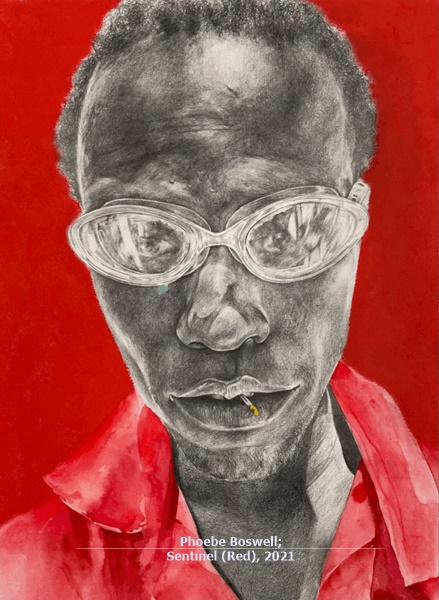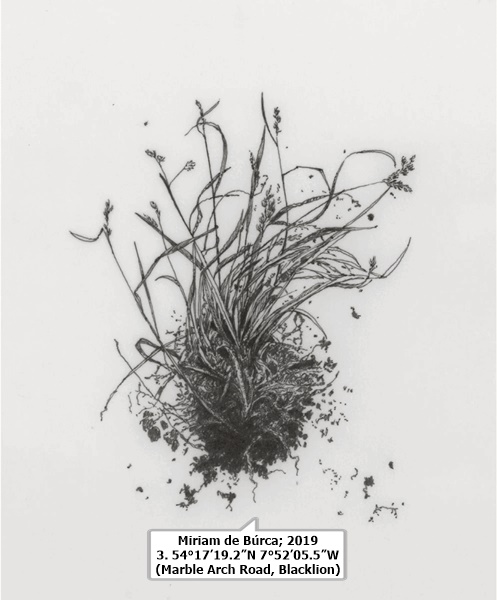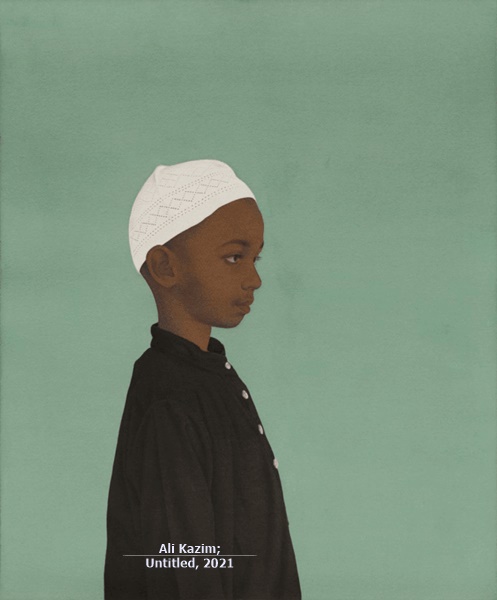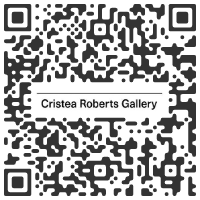"Portraits of People and Place"
Phoebe Boswell, Miriam de Búrca, Ali Kazim

Cristea Roberts Gallery
43 Pall Mall, St. James's, London SW1Y 5JG U.K.T. +44 20 7439 1866 e-mail:



10 June > 9 July, 2022



Portraits of People and Place is an exhibition featuring three international artists who all make figurative drawings and paintings: Phoebe Boswell (b. 1982), Miriam de Búrca (b.1972) and Ali Kazim (b.1979).
Each artist is interested in a sense of place and ancestry, as well as personal and social history. They make work which relates to where they come from, about the people and the history of a place. Each artist looks to the landscape and people around them to talk about a present which has been shaped by the past.
"It feels to me like it’s legacies that we are all making portraits of... We look to landscapes and people to talk about a present profoundly shaped by the past. Inherited futures." Miriam de Búrca
Phoebe Boswell was born in Nairobi and grew up in the Arabian Gulf before moving to the UK. Her work, which spans media from drawing to film, explores the multi-faceted nature of the diasporic experience. Portraits of People and Place features large-scale portraits, by Boswell, of fisherman returning from a long, arduous expedition, who she encountered on the beach near her family home in Zanzibar, Tanzania, whose generational relationship with the sea is being challenged through a combination of climate change, tourism and overfishing.
Five portraits, on brightly coloured backgrounds, entitled Future Ancestors: Sentinels, 2021, and a larger diptych, Somewhere Between Errantry and Exile, 2021, are made using a combination of graphite, pastel, Indian ink and watercolour on paper. Boswell comments; “These drawings stem from the initial encounter but expand through time and geography to a more fictional space where I honour and reimagine them as Future Ancestors, sentinels who’ve been off in search of a New Place.
I want to celebrate these men, to honour the necessary - the strength, the wisdom, the spirituality, the resilience, the imagination – we all need to find this New Place. Because, historically, Zanzibar was a slave port, and their knowledge of the sea, even though so absolute, so ancestral, so much part of their bodies, this tidalectic wisdom was an adapted skill, which their forefathers had to learn and improvise when they were brought over from the mainland in boats and subjected to the worst of modernity’s cruelty. So I started thinking about Future Ancestors as a call to remember and also a call to arms. We need to know how resilient and adaptive we are in order for our imaginations to begin to envision a new place.
Miriam de Búrca was born in Germany but raised in Ireland, later studying in Glasgow and Belfast. She now lives and works in Galway, Ireland. A theme that has permeated de Búrcas' work, a practice centred around drawing, is her personal experience of persisting divisions in Northern Ireland.
The exhibition includes twenty-four drawings by de Búrca, entitled Sampling the Border, 2021, made in response to Brexit and discussions around the possible reinstatement of a hard border between North and South Ireland, which would potentially destabilise the region.
De Búrca travelled to the North to document the border landscape. Over the past twenty years since the border infrastructure was dismantled, the once dangerous, heavily militarised no-man's land, is now a soft, rich, green belt. De Búrca selected intersections along the border’s entire length of almost 500 km, from Warrenpoint to Derry, that were accessible by car or foot. She walked across the land, taking samples of plant life - sods of earth, grasses, weeds, leaves - growing on what she discerned as the dividing line - back to her studio to make a series of intricately detailed drawings.
De Búrca comments; “I have titled them according to their coordinates rather than their botanical names because I want to shift the attention to their location – for place to be what their identification was determined by, not 'race'. If a hard border is re-installed, I will go back and re-document the sites I visited and record the destruction to the landscapes and communities that a hard border would inflict. This is a work in progress, but one that I sincerely hope I never get to finish.”
Further drawings in the exhibition focus on burial sites in Ireland called cillíní, which were used to bury unbaptised babies (until as recently as the 1980s) and many others considered ‘unsuitable’ for consecrated ground. Unmarried mothers, the mentally ill, unknown strangers, disabled children (or ‘changelings’), suicides and excommunicates, were all laid to rest here, exiled to a state of eternal limbo. From these grounds de Búrca also makes detailed studies of plant life.
De Búrca’s drawings take the conversation about land and its meaning to a place of contemplation, remembrance and recognition. In making these portraits of particular places which are so loaded with meaning, she draws our attention to the potent history of what is often hidden beneath our feet.
Ali Kazim was born in Pakistan, in a village a two-hour drive from the capital, Lahore, where the artist now lives and works. Whilst studying to become a nurse, Kazim practiced freehand drawing in the evenings. He later graduated from the National College of Arts in Lahore and Slade School of Fine Art, London.
Five figurative watercolours by Kazim, from his series Man of Faith and Children of Faith, 2021, will be included in the exhibition. Each portrait features a figure of religious faith on a background of pure saturated colour. The solitary single figures, often known to Kazim or sometimes strangers he has photographed on the street, cannot be readily located historically or geographically. Kazim refuses to specify time or location, so that the viewer is invited to look closely at the details of their profiles, features and clothing.
“Mostly floating against unmodulated backgrounds, saturated with thin layers of watercolour washes, the subjects have a monumental dignity, suspended in space and time. The subjects of the portraits are not depicted in an urban or domestic setting. They don’t easily suggest an obvious place, but the painted brown skinned people immediately locate themselves within a broader South Asian arena, a land of many languages, religions, and beliefs. Perhaps the association of the sitter with these beliefs and practices make my characters more enchanted."
Kazim is inspired by the art and history of the Indian subcontinent; Gandharan sculptures, Mughal miniature painting, and the Bengal School’s watercolourists, whose wash technique he also studied.
The process of making the watercolours is very slow. After an initial drawing, Kazim applies diluted washes of different colours on the selected parts of the painting, which is then washed in shallow water, so that the pigment becomes fixed. A repetitive and attentive act, Kazim repeats this process multiple times. Working in the relentless heat of Pakistan, it can take two months to finish one painting.
Each artist is interested in a sense of place and ancestry, as well as personal and social history. They make work which relates to where they come from, about the people and the history of a place. Each artist looks to the landscape and people around them to talk about a present which has been shaped by the past.
"It feels to me like it’s legacies that we are all making portraits of... We look to landscapes and people to talk about a present profoundly shaped by the past. Inherited futures." Miriam de Búrca
Phoebe Boswell was born in Nairobi and grew up in the Arabian Gulf before moving to the UK. Her work, which spans media from drawing to film, explores the multi-faceted nature of the diasporic experience. Portraits of People and Place features large-scale portraits, by Boswell, of fisherman returning from a long, arduous expedition, who she encountered on the beach near her family home in Zanzibar, Tanzania, whose generational relationship with the sea is being challenged through a combination of climate change, tourism and overfishing.
Five portraits, on brightly coloured backgrounds, entitled Future Ancestors: Sentinels, 2021, and a larger diptych, Somewhere Between Errantry and Exile, 2021, are made using a combination of graphite, pastel, Indian ink and watercolour on paper. Boswell comments; “These drawings stem from the initial encounter but expand through time and geography to a more fictional space where I honour and reimagine them as Future Ancestors, sentinels who’ve been off in search of a New Place.
I want to celebrate these men, to honour the necessary - the strength, the wisdom, the spirituality, the resilience, the imagination – we all need to find this New Place. Because, historically, Zanzibar was a slave port, and their knowledge of the sea, even though so absolute, so ancestral, so much part of their bodies, this tidalectic wisdom was an adapted skill, which their forefathers had to learn and improvise when they were brought over from the mainland in boats and subjected to the worst of modernity’s cruelty. So I started thinking about Future Ancestors as a call to remember and also a call to arms. We need to know how resilient and adaptive we are in order for our imaginations to begin to envision a new place.
Miriam de Búrca was born in Germany but raised in Ireland, later studying in Glasgow and Belfast. She now lives and works in Galway, Ireland. A theme that has permeated de Búrcas' work, a practice centred around drawing, is her personal experience of persisting divisions in Northern Ireland.
The exhibition includes twenty-four drawings by de Búrca, entitled Sampling the Border, 2021, made in response to Brexit and discussions around the possible reinstatement of a hard border between North and South Ireland, which would potentially destabilise the region.
De Búrca travelled to the North to document the border landscape. Over the past twenty years since the border infrastructure was dismantled, the once dangerous, heavily militarised no-man's land, is now a soft, rich, green belt. De Búrca selected intersections along the border’s entire length of almost 500 km, from Warrenpoint to Derry, that were accessible by car or foot. She walked across the land, taking samples of plant life - sods of earth, grasses, weeds, leaves - growing on what she discerned as the dividing line - back to her studio to make a series of intricately detailed drawings.
De Búrca comments; “I have titled them according to their coordinates rather than their botanical names because I want to shift the attention to their location – for place to be what their identification was determined by, not 'race'. If a hard border is re-installed, I will go back and re-document the sites I visited and record the destruction to the landscapes and communities that a hard border would inflict. This is a work in progress, but one that I sincerely hope I never get to finish.”
Further drawings in the exhibition focus on burial sites in Ireland called cillíní, which were used to bury unbaptised babies (until as recently as the 1980s) and many others considered ‘unsuitable’ for consecrated ground. Unmarried mothers, the mentally ill, unknown strangers, disabled children (or ‘changelings’), suicides and excommunicates, were all laid to rest here, exiled to a state of eternal limbo. From these grounds de Búrca also makes detailed studies of plant life.
De Búrca’s drawings take the conversation about land and its meaning to a place of contemplation, remembrance and recognition. In making these portraits of particular places which are so loaded with meaning, she draws our attention to the potent history of what is often hidden beneath our feet.
Ali Kazim was born in Pakistan, in a village a two-hour drive from the capital, Lahore, where the artist now lives and works. Whilst studying to become a nurse, Kazim practiced freehand drawing in the evenings. He later graduated from the National College of Arts in Lahore and Slade School of Fine Art, London.
Five figurative watercolours by Kazim, from his series Man of Faith and Children of Faith, 2021, will be included in the exhibition. Each portrait features a figure of religious faith on a background of pure saturated colour. The solitary single figures, often known to Kazim or sometimes strangers he has photographed on the street, cannot be readily located historically or geographically. Kazim refuses to specify time or location, so that the viewer is invited to look closely at the details of their profiles, features and clothing.
“Mostly floating against unmodulated backgrounds, saturated with thin layers of watercolour washes, the subjects have a monumental dignity, suspended in space and time. The subjects of the portraits are not depicted in an urban or domestic setting. They don’t easily suggest an obvious place, but the painted brown skinned people immediately locate themselves within a broader South Asian arena, a land of many languages, religions, and beliefs. Perhaps the association of the sitter with these beliefs and practices make my characters more enchanted."
Kazim is inspired by the art and history of the Indian subcontinent; Gandharan sculptures, Mughal miniature painting, and the Bengal School’s watercolourists, whose wash technique he also studied.
The process of making the watercolours is very slow. After an initial drawing, Kazim applies diluted washes of different colours on the selected parts of the painting, which is then washed in shallow water, so that the pigment becomes fixed. A repetitive and attentive act, Kazim repeats this process multiple times. Working in the relentless heat of Pakistan, it can take two months to finish one painting.
 | Phoebe Boswell | |
 | Miriam de Búrca | |
 | Ali Kazim | |
Private View :
6 - 7.30pm, Thursday 9 June 2022
Confirm your attendance via
mpefm UNITED KINGDOM art press release
Opening hours:
by appointment on:
Tuesday – Friday: 11am – 5.30pm and on Saturdays: 11am – 2pm.
Visiting the exhibition
All visitors are required to make an appointment prior to their arrival.
QR of this press release
in your phone, tablet








